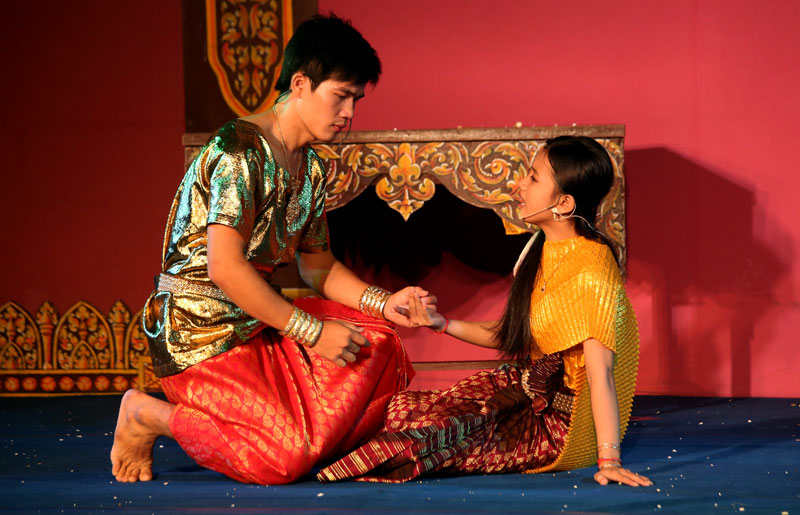A fever-stricken woman lies limp in the arms of a loved one. Villagers surround her, chanting softly. Suddenly, a lone figure rises from the ground and lets out a primal shout. The chanting grows louder.
Rehearsal for “Nary’s Journey,” a headlining performance at this weekend’s Amatak Festival, is in session on the center stage at the National Museum’s Plae Pakaa theater.

The festival, hosted by Cambodia Living Arts (CLA) to celebrate its 15th anniversary, will include a variety of Khmer traditional arts performances. The three-day event will also feature the professional debut of some 120 up-and-coming artists studying traditional theater, music and dance at the Royal University of Fine Arts (RUFA).
Phloeun Prim, executive director of CLA, said the festival is also meant to encourage young Cambodians in Phnom Penh to learn more about their cultural heritage, for free.
“We’ll be showcasing the troupes that we’ve been nurturing for the past 15 years,” he said. “It’s a renewed version of old traditions owned by young Cambodians.”
The Amatak Festival will spotlight 10 musical, dance and theater ensembles from RUFA, plus hands-on workshops, open mic events and discussion sessions with master artists from a variety of disciplines. There will be glimpses of both popular and nearly-extinct art forms, including the Chapey, a long-necked guitar, Yike, Opera-style storytelling, wind instrumentals and dancing martial artists.
Also on the agenda are performances by two visiting troupes from outside Phnom Penh, whose displays of “raw artistry” will be a highlight of the weekend, according to festival producer Suon Bunrith.
The first of these, a musical troupe from Siem Reap, will put on a public performance on the Angkorian harp for the first time in decades. The second, a group of spiritual cantors—or Smot singers—will recite Buddhist dharma poetry through an art form that Bunrith says is now endangered.
“It is amazing to hear,” Mr. Bunrith said about Smot. “It’s about the ritual, not the performance. It’s real, living art for the Cambodian people.”
“Nary’s Journey,” a drama directed by French-Khmer playwright Jean-Baptise Phou, is set to headline the festival’s invitation-only launch on Friday evening. The play tells the story of a Cambodian city girl’s rediscovery of her roots when an illness in the family prompts a return trip to her childhood village.
Mr. Phou said he wanted to create a piece that explores universal themes—relationships within families, for example—while highlighting elements unique to Cambodian culture. To this end, the play will use traditional music, dance and storytelling techniques to depict time-honored Khmer rituals.
The underlying narrative of loss and rediscovery of cultural identity is at the heart of the festival, which aims to instill a sense of appreciation for traditional arts in Cambodian youth—many of who have completely lost touch with their cultural roots, according to Mr. Bunrith.
“They know all about pop culture, but what about their own culture?” he said. “When it comes to traditions like Bassac theater, Yike, Smot…there are a lot of questions in their heads.”
He said most young Cambodians are unaware of traditional art forms and customs, primarily due to a lack of opportunities to learn about them. Globalization also plays a role, he said, as the influences of Western media and Korean popular culture become increasingly prevalent in the country.
Many young Cambodians, Mr. Bunrith said, can’t even recognize basic traditional instruments. “It hurts me a lot,” he said. “I just think: ‘How? This is who you are!’”
Srin Sokmean, a 21-year-old student at the Institute of Foreign Languages, is a regular patron of traditional arts shows at Phnom Penh’s Chaktomuk Theater—one of just two places in the city where such performances are still held.
Mr. Sokmean says some in his generation want to keep Khmer traditional arts alive, but a “lack of promotion” combined with the strong presence of foreign influences in Cambodia makes it difficult to garner interest among their peers.
“The popularity of Khmer traditional arts is diminishing,” he said. “Kids nowadays grow up with the influence of other cultures, like watching Korean movies.”
But hope remains. Mr. Phou said Cambodia’s music scene is entering a “really interesting stage,” where cultural revival efforts are converging with the global music scene to produce an entirely new style of artistic expression.
And at the forefront of the new music movement are youth.
“I’m seeing this trend,” he said, “of young people using traditional instruments to create new rhythms and new sounds, but blended with Western influences.”
Mr. Prim, CLA’s director, said the future of Khmer traditional arts depends on how the next generation chooses to make it their own. He said the key to preservation is creating a space for young, globally connected Cambodians to keep age-old traditions fresh and relevant.
“It’s not necessarily about conservation,” he said. “It’s about traditions, but also about the way today’s young, new generation interprets those art forms.”



